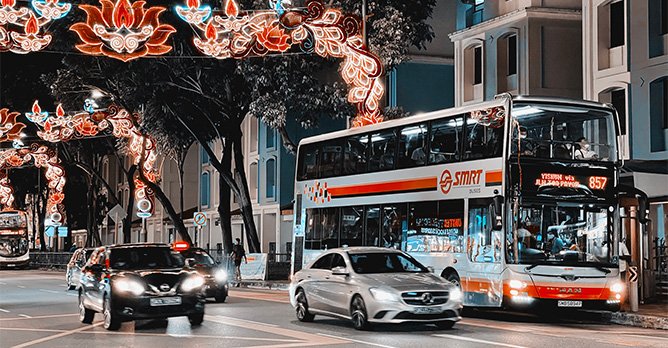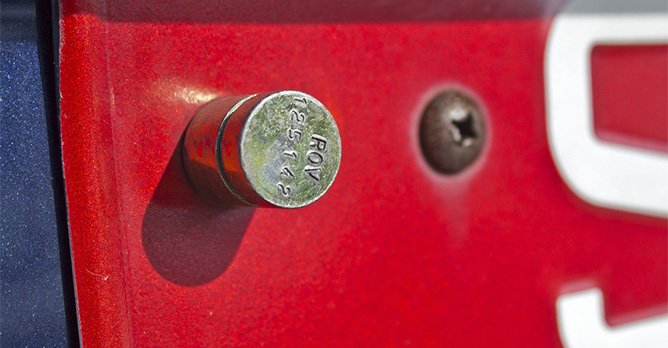Six things only red-plate drivers can relate to
20 Sep 2022|11,599 views
In case you haven't heard, red-plates are becoming increasingly rare to find: The OPC-population has been on a steady decline since peaking in 2010, and the situation doesn't look like it will be changing any time soon.
What this means is that what was already a relatively obscure experience is under threat yet of getting scrubbed even further from the consciousness of public memory. Before that happens, here's a recap of some specific things only red-plate drivers can relate to that may provide some insight into the experience of off-peak car-ownership.
1. Being extra excited about knocking off work, the weekends, and PHs (plus eves of PHs)...
No, you don't get to say that you're looking forward as much to finally logging off and muting your notifications on Teams at the end of the day if you drive a normally registered car.
Since OPCs are relegated to their parking lots from 7am to 7pm on weekdays, the end of the work day holds extra meaning for their drivers: It means finally being able get behind the wheel and out on the road (again).
Under the Revised Off-Peak Car (ROPC) scheme that was rolled out in 2010, more flashes of red can also now be seen for the entirety of Saturdays and selected eves of public holidays as well. We could only drive out after 3:00pm on these days under the old scheme.
2. ...but also getting frustrated because your car servicing centre doesn't offer weekend slots.
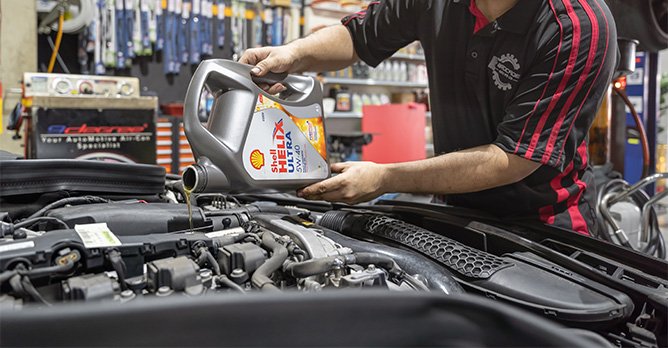
 Many OPC-drivers should know the pain of buying a day license solely to send their car for servicing Outside of the restricted hours, OPC-drivers still have the freedom to hunt for the best cafes and restaurants... but guess what they're likely not to find open past 7:00pm on weekdays? Workshops.
Many OPC-drivers should know the pain of buying a day license solely to send their car for servicing Outside of the restricted hours, OPC-drivers still have the freedom to hunt for the best cafes and restaurants... but guess what they're likely not to find open past 7:00pm on weekdays? Workshops.
In a system where every single full day (or even hour) of driving feels extra precious, the thought of handing your car over for a routine check-up for a good few hours is already quite painful (this duration is more typical of those provided by authorised dealers). Worse, however, is the scenario in which your servicing centre operates for just half a day on weekends.
For servicing intervals that require more work carried out, those operating hours simply won't suffice. Paying $20 - just to drive your car to the servicing centre at 9:00am, then collect it around 4:00pm or 5:00pm - feels as senseless as it sounds, but this is the reality OPC-drivers are confronted with sometimes.
3. Scrambling to buy your e-day license before the clock strikes midnight, the day after you've driven out on a weekday…
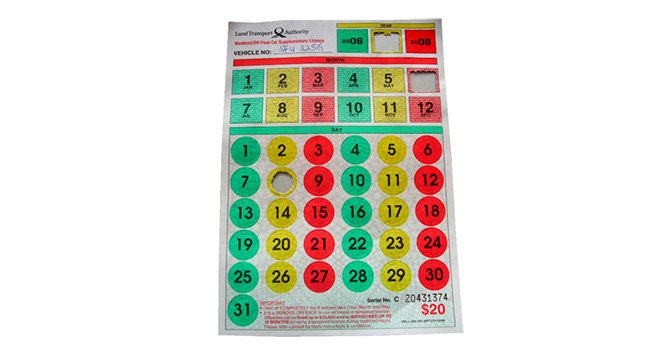
 Prior to the introduction of the e-day license, this colourful coupon had to be punched out and displayed before driving during restricted hours Another initiative introduced at the close of the 2000s was an electronic update to the regulation system, to bring more convenience to OPC-drivers.
Prior to the introduction of the e-day license, this colourful coupon had to be punched out and displayed before driving during restricted hours Another initiative introduced at the close of the 2000s was an electronic update to the regulation system, to bring more convenience to OPC-drivers.
Since 2009, motorists have been able to obtain an 'e-day license' (at the same cost of $20 per day) via the OneMotoring website. With the usage of OPCs registered via digital, paperless means into LTA's records, the technicolour coupon of old was quickly also made obsolete.
Most OPC-drivers are likely to have unreserved praise for the revision. Driving out on a weekday is sometimes quite a spontaneous affair, and not needing to ensure a coupon is nicely punched out and displayed on one's dash allows you to carry on with your errands at your convenience first, before paying for the day's usage later on.
With this extra freedom, however, also comes some complacency. The system is actually more lenient than before - payment for an e-day license can be made up till 11:59pm on the day after driving out - but even this extension is no match sometimes for a forgetful (and tired) mind. Cue flashbacks to the sudden thunderbolt of realisation, then quick tapping away at one's smartphone on some frenzied 11:00pm nights.
4. ...then dealing with the hefty fines if you've clean forgotten.
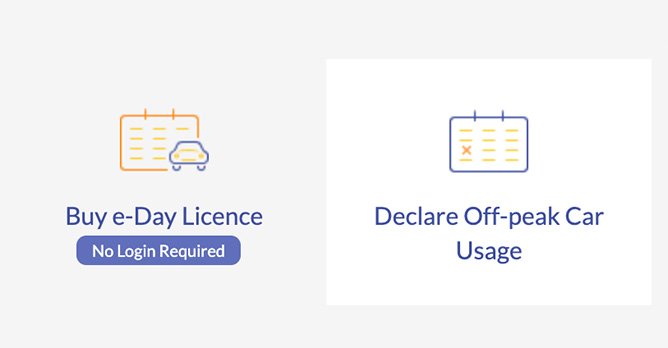
 If a driver has failed to buy their license on time, usage of their car during restricted hours can still be declared up till five days after the initial day of use Unfortunately, the extra grace extended also means that the authorities will come down quite hard if one ultimately fails to pay up.
If a driver has failed to buy their license on time, usage of their car during restricted hours can still be declared up till five days after the initial day of use Unfortunately, the extra grace extended also means that the authorities will come down quite hard if one ultimately fails to pay up.
Should you miss the first deadline, yet another (final) lifeline remains: You can still declare your usage of the car up to five days after the initial day of use. Nevertheless, you'll have to cough up $30 - an extra $10 - as a 'belated' license of sorts.
Any later, however, and the financial punishment shoots up exponentially. Fines for uncovered/undeclared usage can rise into the low hundreds for first-time offenders, and, as many of us experienced folk will likely lament, are virtually impossible to appeal.
This really doesn't make sense since you'd be blowing through the equivalent of a good 10 to 20 e-day licenses in one sitting. As such, most of us invariably learn the value of punctuality (painfully) after a while.
5. Dreading the annual drive to JIC/STA/VICOM for an extra red-plate seal inspection...
Those who enjoy buying their cars brand-new get to enjoy close to three years of peace - free from the angst-inducing queues of a vehicle inspection centre - before having to send their vehicles in.
Things are different, however, for OPC-owners. To ensure that there's been no tampering, an extra, special golden seal comes attached to every red plate. An annual trip down to the inspection centre is consequently necessary prior to road tax-renewal, so that the seal can be checked.
This is naturally a slight bugbear for us OPC-drivers: No one leaps out of bed full of life and energy on the day they have to head down to an inspection centre, and we're guaranteed to have at least a few more of these in our years of driving. Thankfully, the procedure is quite snappy (once it's your turn) and relatively inexpensive at $10.70. Also, since we're speaking about road tax…
6. ... then feeling less stressed than your friends when the road-tax payment slip arrives.
The chances of stumbling upon a luxury vehicle with a red plate are slim to none. After all, OPCs are more justified as 'mass market' models, since the upfront rebate was designed to significantly reduce their retail prices - or at least this used to be so a long time ago (in a COE galaxy far, far away).
Such cars also tend to come with smaller engines and lower power outputs, which already translate into a road tax bill that's unlikely to break the bank. The power of the red-plate, however, slices up to another $500 off, meaning the owner of something like the current Honda Civic will have to pay just $186 when the inevitable time of the year arrives. Sweet.
The catch, though, is a that a price floor of $70 remains regardless. That means drivers of cars with tiny engines (like the Mitsubishi Attrage or Volkswagen Polo) - whose road tax amounts already hover around $500 - are also locked out of enjoying the full rebate. (Ah, but whoever said the balancing act of squeezing the most out of the OPC-scheme was an easy one?)
What this means is that what was already a relatively obscure experience is under threat yet of getting scrubbed even further from the consciousness of public memory. Before that happens, here's a recap of some specific things only red-plate drivers can relate to that may provide some insight into the experience of off-peak car-ownership.
1. Being extra excited about knocking off work, the weekends, and PHs (plus eves of PHs)...
No, you don't get to say that you're looking forward as much to finally logging off and muting your notifications on Teams at the end of the day if you drive a normally registered car.
Since OPCs are relegated to their parking lots from 7am to 7pm on weekdays, the end of the work day holds extra meaning for their drivers: It means finally being able get behind the wheel and out on the road (again).
Under the Revised Off-Peak Car (ROPC) scheme that was rolled out in 2010, more flashes of red can also now be seen for the entirety of Saturdays and selected eves of public holidays as well. We could only drive out after 3:00pm on these days under the old scheme.
2. ...but also getting frustrated because your car servicing centre doesn't offer weekend slots.

In a system where every single full day (or even hour) of driving feels extra precious, the thought of handing your car over for a routine check-up for a good few hours is already quite painful (this duration is more typical of those provided by authorised dealers). Worse, however, is the scenario in which your servicing centre operates for just half a day on weekends.
For servicing intervals that require more work carried out, those operating hours simply won't suffice. Paying $20 - just to drive your car to the servicing centre at 9:00am, then collect it around 4:00pm or 5:00pm - feels as senseless as it sounds, but this is the reality OPC-drivers are confronted with sometimes.
3. Scrambling to buy your e-day license before the clock strikes midnight, the day after you've driven out on a weekday…

Since 2009, motorists have been able to obtain an 'e-day license' (at the same cost of $20 per day) via the OneMotoring website. With the usage of OPCs registered via digital, paperless means into LTA's records, the technicolour coupon of old was quickly also made obsolete.
Most OPC-drivers are likely to have unreserved praise for the revision. Driving out on a weekday is sometimes quite a spontaneous affair, and not needing to ensure a coupon is nicely punched out and displayed on one's dash allows you to carry on with your errands at your convenience first, before paying for the day's usage later on.
With this extra freedom, however, also comes some complacency. The system is actually more lenient than before - payment for an e-day license can be made up till 11:59pm on the day after driving out - but even this extension is no match sometimes for a forgetful (and tired) mind. Cue flashbacks to the sudden thunderbolt of realisation, then quick tapping away at one's smartphone on some frenzied 11:00pm nights.
4. ...then dealing with the hefty fines if you've clean forgotten.

Should you miss the first deadline, yet another (final) lifeline remains: You can still declare your usage of the car up to five days after the initial day of use. Nevertheless, you'll have to cough up $30 - an extra $10 - as a 'belated' license of sorts.
Any later, however, and the financial punishment shoots up exponentially. Fines for uncovered/undeclared usage can rise into the low hundreds for first-time offenders, and, as many of us experienced folk will likely lament, are virtually impossible to appeal.
This really doesn't make sense since you'd be blowing through the equivalent of a good 10 to 20 e-day licenses in one sitting. As such, most of us invariably learn the value of punctuality (painfully) after a while.
5. Dreading the annual drive to JIC/STA/VICOM for an extra red-plate seal inspection...
Those who enjoy buying their cars brand-new get to enjoy close to three years of peace - free from the angst-inducing queues of a vehicle inspection centre - before having to send their vehicles in.
Things are different, however, for OPC-owners. To ensure that there's been no tampering, an extra, special golden seal comes attached to every red plate. An annual trip down to the inspection centre is consequently necessary prior to road tax-renewal, so that the seal can be checked.
This is naturally a slight bugbear for us OPC-drivers: No one leaps out of bed full of life and energy on the day they have to head down to an inspection centre, and we're guaranteed to have at least a few more of these in our years of driving. Thankfully, the procedure is quite snappy (once it's your turn) and relatively inexpensive at $10.70. Also, since we're speaking about road tax…
6. ... then feeling less stressed than your friends when the road-tax payment slip arrives.
The chances of stumbling upon a luxury vehicle with a red plate are slim to none. After all, OPCs are more justified as 'mass market' models, since the upfront rebate was designed to significantly reduce their retail prices - or at least this used to be so a long time ago (in a COE galaxy far, far away).
Such cars also tend to come with smaller engines and lower power outputs, which already translate into a road tax bill that's unlikely to break the bank. The power of the red-plate, however, slices up to another $500 off, meaning the owner of something like the current Honda Civic will have to pay just $186 when the inevitable time of the year arrives. Sweet.
The catch, though, is a that a price floor of $70 remains regardless. That means drivers of cars with tiny engines (like the Mitsubishi Attrage or Volkswagen Polo) - whose road tax amounts already hover around $500 - are also locked out of enjoying the full rebate. (Ah, but whoever said the balancing act of squeezing the most out of the OPC-scheme was an easy one?)
In case you haven't heard, red-plates are becoming increasingly rare to find: The OPC-population has been on a steady decline since peaking in 2010, and the situation doesn't look like it will be changing any time soon.
What this means is that what was already a relatively obscure experience is under threat yet of getting scrubbed even further from the consciousness of public memory. Before that happens, here's a recap of some specific things only red-plate drivers can relate to that may provide some insight into the experience of off-peak car-ownership.
1. Being extra excited about knocking off work, the weekends, and PHs (plus eves of PHs)...
No, you don't get to say that you're looking forward as much to finally logging off and muting your notifications on Teams at the end of the day if you drive a normally registered car.
Since OPCs are relegated to their parking lots from 7am to 7pm on weekdays, the end of the work day holds extra meaning for their drivers: It means finally being able get behind the wheel and out on the road (again).
Under the Revised Off-Peak Car (ROPC) scheme that was rolled out in 2010, more flashes of red can also now be seen for the entirety of Saturdays and selected eves of public holidays as well. We could only drive out after 3:00pm on these days under the old scheme.
2. ...but also getting frustrated because your car servicing centre doesn't offer weekend slots.

 Many OPC-drivers should know the pain of buying a day license solely to send their car for servicing Outside of the restricted hours, OPC-drivers still have the freedom to hunt for the best cafes and restaurants... but guess what they're likely not to find open past 7:00pm on weekdays? Workshops.
Many OPC-drivers should know the pain of buying a day license solely to send their car for servicing Outside of the restricted hours, OPC-drivers still have the freedom to hunt for the best cafes and restaurants... but guess what they're likely not to find open past 7:00pm on weekdays? Workshops.
In a system where every single full day (or even hour) of driving feels extra precious, the thought of handing your car over for a routine check-up for a good few hours is already quite painful (this duration is more typical of those provided by authorised dealers). Worse, however, is the scenario in which your servicing centre operates for just half a day on weekends.
For servicing intervals that require more work carried out, those operating hours simply won't suffice. Paying $20 - just to drive your car to the servicing centre at 9:00am, then collect it around 4:00pm or 5:00pm - feels as senseless as it sounds, but this is the reality OPC-drivers are confronted with sometimes.
3. Scrambling to buy your e-day license before the clock strikes midnight, the day after you've driven out on a weekday…

 Prior to the introduction of the e-day license, this colourful coupon had to be punched out and displayed before driving during restricted hours Another initiative introduced at the close of the 2000s was an electronic update to the regulation system, to bring more convenience to OPC-drivers.
Prior to the introduction of the e-day license, this colourful coupon had to be punched out and displayed before driving during restricted hours Another initiative introduced at the close of the 2000s was an electronic update to the regulation system, to bring more convenience to OPC-drivers.
Since 2009, motorists have been able to obtain an 'e-day license' (at the same cost of $20 per day) via the OneMotoring website. With the usage of OPCs registered via digital, paperless means into LTA's records, the technicolour coupon of old was quickly also made obsolete.
Most OPC-drivers are likely to have unreserved praise for the revision. Driving out on a weekday is sometimes quite a spontaneous affair, and not needing to ensure a coupon is nicely punched out and displayed on one's dash allows you to carry on with your errands at your convenience first, before paying for the day's usage later on.
With this extra freedom, however, also comes some complacency. The system is actually more lenient than before - payment for an e-day license can be made up till 11:59pm on the day after driving out - but even this extension is no match sometimes for a forgetful (and tired) mind. Cue flashbacks to the sudden thunderbolt of realisation, then quick tapping away at one's smartphone on some frenzied 11:00pm nights.
4. ...then dealing with the hefty fines if you've clean forgotten.


If a driver has failed to buy their license on time, usage of their car during restricted hours can still be declared up till five days after the initial day of use Unfortunately, the extra grace extended also means that the authorities will come down quite hard if one ultimately fails to pay up.
Should you miss the first deadline, yet another (final) lifeline remains: You can still declare your usage of the car up to five days after the initial day of use. Nevertheless, you'll have to cough up $30 - an extra $10 - as a 'belated' license of sorts.
Any later, however, and the financial punishment shoots up exponentially. Fines for uncovered/undeclared usage can rise into the low hundreds for first-time offenders, and, as many of us experienced folk will likely lament, are virtually impossible to appeal.
This really doesn't make sense since you'd be blowing through the equivalent of a good 10 to 20 e-day licenses in one sitting. As such, most of us invariably learn the value of punctuality (painfully) after a while.
5. Dreading the annual drive to JIC/STA/VICOM for an extra red-plate seal inspection...
Those who enjoy buying their cars brand-new get to enjoy close to three years of peace - free from the angst-inducing queues of a vehicle inspection centre - before having to send their vehicles in.
Things are different, however, for OPC-owners. To ensure that there's been no tampering, an extra, special golden seal comes attached to every red plate. An annual trip down to the inspection centre is consequently necessary prior to road tax-renewal, so that the seal can be checked.
This is naturally a slight bugbear for us OPC-drivers: No one leaps out of bed full of life and energy on the day they have to head down to an inspection centre, and we're guaranteed to have at least a few more of these in our years of driving. Thankfully, the procedure is quite snappy (once it's your turn) and relatively inexpensive at $10.70. Also, since we're speaking about road tax…
6. ... then feeling less stressed than your friends when the road-tax payment slip arrives.
The chances of stumbling upon a luxury vehicle with a red plate are slim to none. After all, OPCs are more justified as 'mass market' models, since the upfront rebate was designed to significantly reduce their retail prices - or at least this used to be so a long time ago (in a COE galaxy far, far away).
Such cars also tend to come with smaller engines and lower power outputs, which already translate into a road tax bill that's unlikely to break the bank. The power of the red-plate, however, slices up to another $500 off, meaning the owner of something like the current Honda Civic will have to pay just $186 when the inevitable time of the year arrives. Sweet.
The catch, though, is a that a price floor of $70 remains regardless. That means drivers of cars with tiny engines (like the Mitsubishi Attrage or Volkswagen Polo) - whose road tax amounts already hover around $500 - are also locked out of enjoying the full rebate. (Ah, but whoever said the balancing act of squeezing the most out of the OPC-scheme was an easy one?)
What this means is that what was already a relatively obscure experience is under threat yet of getting scrubbed even further from the consciousness of public memory. Before that happens, here's a recap of some specific things only red-plate drivers can relate to that may provide some insight into the experience of off-peak car-ownership.
1. Being extra excited about knocking off work, the weekends, and PHs (plus eves of PHs)...
No, you don't get to say that you're looking forward as much to finally logging off and muting your notifications on Teams at the end of the day if you drive a normally registered car.
Since OPCs are relegated to their parking lots from 7am to 7pm on weekdays, the end of the work day holds extra meaning for their drivers: It means finally being able get behind the wheel and out on the road (again).
Under the Revised Off-Peak Car (ROPC) scheme that was rolled out in 2010, more flashes of red can also now be seen for the entirety of Saturdays and selected eves of public holidays as well. We could only drive out after 3:00pm on these days under the old scheme.
2. ...but also getting frustrated because your car servicing centre doesn't offer weekend slots.

In a system where every single full day (or even hour) of driving feels extra precious, the thought of handing your car over for a routine check-up for a good few hours is already quite painful (this duration is more typical of those provided by authorised dealers). Worse, however, is the scenario in which your servicing centre operates for just half a day on weekends.
For servicing intervals that require more work carried out, those operating hours simply won't suffice. Paying $20 - just to drive your car to the servicing centre at 9:00am, then collect it around 4:00pm or 5:00pm - feels as senseless as it sounds, but this is the reality OPC-drivers are confronted with sometimes.
3. Scrambling to buy your e-day license before the clock strikes midnight, the day after you've driven out on a weekday…

Since 2009, motorists have been able to obtain an 'e-day license' (at the same cost of $20 per day) via the OneMotoring website. With the usage of OPCs registered via digital, paperless means into LTA's records, the technicolour coupon of old was quickly also made obsolete.
Most OPC-drivers are likely to have unreserved praise for the revision. Driving out on a weekday is sometimes quite a spontaneous affair, and not needing to ensure a coupon is nicely punched out and displayed on one's dash allows you to carry on with your errands at your convenience first, before paying for the day's usage later on.
With this extra freedom, however, also comes some complacency. The system is actually more lenient than before - payment for an e-day license can be made up till 11:59pm on the day after driving out - but even this extension is no match sometimes for a forgetful (and tired) mind. Cue flashbacks to the sudden thunderbolt of realisation, then quick tapping away at one's smartphone on some frenzied 11:00pm nights.
4. ...then dealing with the hefty fines if you've clean forgotten.

If a driver has failed to buy their license on time, usage of their car during restricted hours can still be declared up till five days after the initial day of use
Should you miss the first deadline, yet another (final) lifeline remains: You can still declare your usage of the car up to five days after the initial day of use. Nevertheless, you'll have to cough up $30 - an extra $10 - as a 'belated' license of sorts.
Any later, however, and the financial punishment shoots up exponentially. Fines for uncovered/undeclared usage can rise into the low hundreds for first-time offenders, and, as many of us experienced folk will likely lament, are virtually impossible to appeal.
This really doesn't make sense since you'd be blowing through the equivalent of a good 10 to 20 e-day licenses in one sitting. As such, most of us invariably learn the value of punctuality (painfully) after a while.
5. Dreading the annual drive to JIC/STA/VICOM for an extra red-plate seal inspection...
Those who enjoy buying their cars brand-new get to enjoy close to three years of peace - free from the angst-inducing queues of a vehicle inspection centre - before having to send their vehicles in.
Things are different, however, for OPC-owners. To ensure that there's been no tampering, an extra, special golden seal comes attached to every red plate. An annual trip down to the inspection centre is consequently necessary prior to road tax-renewal, so that the seal can be checked.
This is naturally a slight bugbear for us OPC-drivers: No one leaps out of bed full of life and energy on the day they have to head down to an inspection centre, and we're guaranteed to have at least a few more of these in our years of driving. Thankfully, the procedure is quite snappy (once it's your turn) and relatively inexpensive at $10.70. Also, since we're speaking about road tax…
6. ... then feeling less stressed than your friends when the road-tax payment slip arrives.
The chances of stumbling upon a luxury vehicle with a red plate are slim to none. After all, OPCs are more justified as 'mass market' models, since the upfront rebate was designed to significantly reduce their retail prices - or at least this used to be so a long time ago (in a COE galaxy far, far away).
Such cars also tend to come with smaller engines and lower power outputs, which already translate into a road tax bill that's unlikely to break the bank. The power of the red-plate, however, slices up to another $500 off, meaning the owner of something like the current Honda Civic will have to pay just $186 when the inevitable time of the year arrives. Sweet.
The catch, though, is a that a price floor of $70 remains regardless. That means drivers of cars with tiny engines (like the Mitsubishi Attrage or Volkswagen Polo) - whose road tax amounts already hover around $500 - are also locked out of enjoying the full rebate. (Ah, but whoever said the balancing act of squeezing the most out of the OPC-scheme was an easy one?)
Thank You For Your Subscription.







